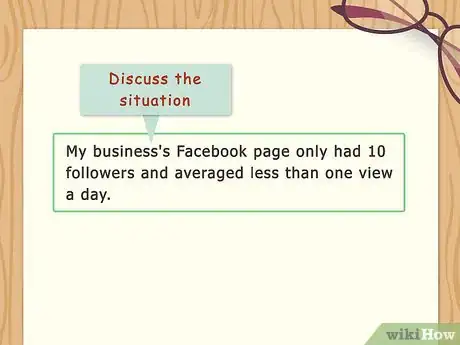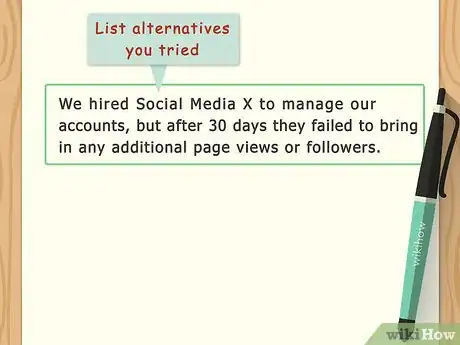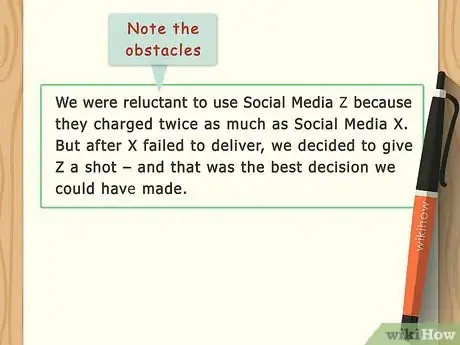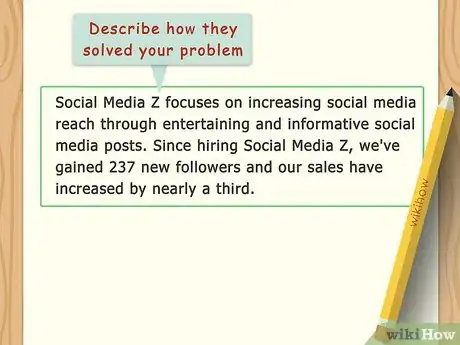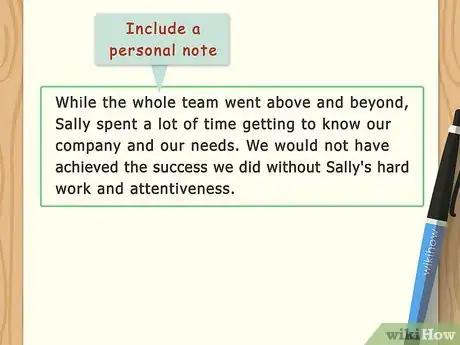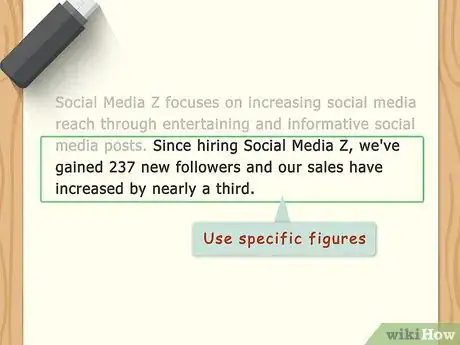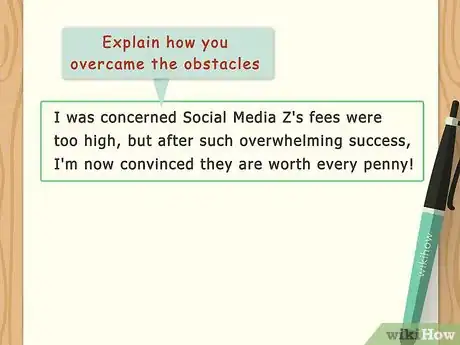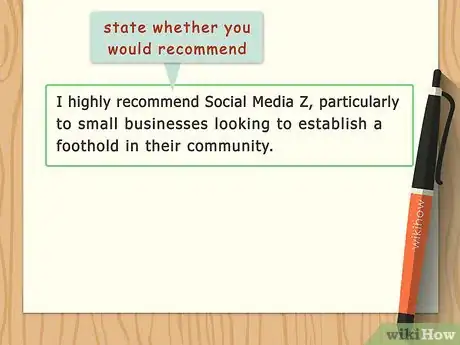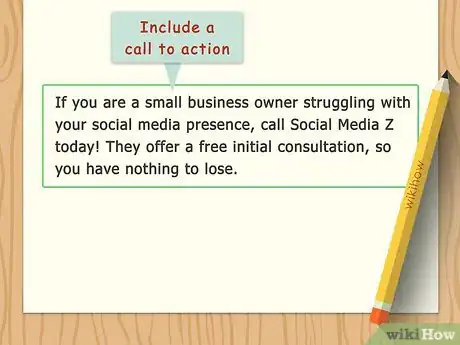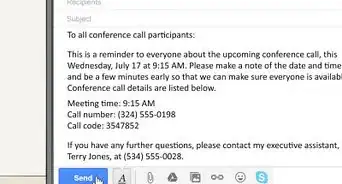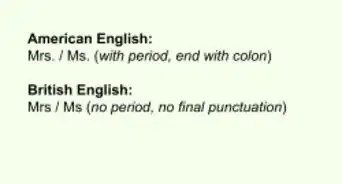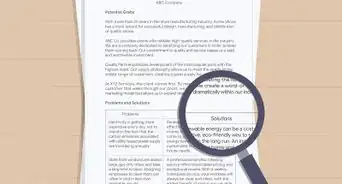This article was co-authored by wikiHow staff writer, Jennifer Mueller, JD. Jennifer Mueller is a wikiHow Content Creator. She specializes in reviewing, fact-checking, and evaluating wikiHow's content to ensure thoroughness and accuracy. Jennifer holds a JD from Indiana University Maurer School of Law in 2006.
This article has been viewed 90,690 times.
Learn more...
Testimonials can be a powerful marketing tool for any business. If you've been approached to write a testimonial, or if you've volunteered to write one, you want it to be as helpful and persuasive as possible. To write a powerful testimonial, start by describing the problem you faced. Then explain how the product or service you're writing about solved your problem. Conclude by recommending the product or service to others.[1]
Steps
Describing Your Problem
-
1Introduce yourself. Start your testimonial with a little bit of information about who you are. Include details that would give your testimonial more weight or make your opinion more valuable.[2]
- How much, and what type, of detail about yourself you include will depend on the product or service for which you're writing your testimonial. Your testimonial should be relatively short, so don't include anything that wouldn't add weight or value to your testimony.
- For example, if you're writing a testimonial about a new herbal dog shampoo, the fact that you're a licensed dog groomer would be important. However, if you were writing a testimonial for a personal trainer, the fact that you are a dog groomer would probably be irrelevant.
-
2Discuss your situation. Open your testimonial by describing the problem that you were facing before you tried the product or service that is the subject of the testimonial. Be brief, but include as many specific facts as possible.[3]
- Facts allow people reading your testimonial to compare your situation before and after you used the product or service. Showing this evidence yourself makes the testimonial more helpful to people.
- Since you still want your testimonial to be brief, only include facts that were directly affected by the product or service. For example, if your business had a problem managing its social media accounts, you might say "My business's Facebook page only had 10 followers and averaged less than one view a day."
Advertisement -
3List alternatives you tried. If relevant, you might also include a line or two about other products or services you used in an attempt to solve your problem. Describe specific ways those products or services failed to help you.[4]
- Listing alternatives can be especially beneficial if you tried a direct competitor and they were unable to solve your problem. To continue with the social media example, you might say "We hired Social Media X to manage our accounts, but after 30 days they failed to bring in any additional page views or followers."
- Include a personal note regarding how it made you feel to try different alternatives and have them all fail. Readers will empathize with you and be drawn into your story.
-
4Note any obstacles. Every product or service has its drawbacks. If there was some reason you initially rejected the product or service you writing about, talk about how you got past that issue. Then you can transition smoothly into the solution of your problem.[5]
- Cost typically is one potential obstacle. For example, you might say, "We were reluctant to use Social Media Z because they charged twice as much as Social Media X. But after X failed to deliver, we decided to give Z a shot – and that was the best decision we could have made."
Demonstrating the Benefit
-
1Describe how the product or service solved your problem. Start a new paragraph, and turn your attention to the product or service you're writing your testimonial about. List two or three important facts about the product or service.[6]
- Take a moment to introduce the product or service and talk a little about what it is or what it does. Then state specifically what it did for you and how it helped you.
- For example, you might say "Social Media Z focuses on increasing social media reach through entertaining and informative social media posts. Since hiring Social Media Z, we've gained 237 new followers and our sales have increased by nearly a third."
- Highlight a unique or creative approach. If there's something about the business or product that sets it apart from competitors, talk about that thing specifically. Mention if custom solutions were offered that were tailored specifically to your problem.[7]
- It can help to describe your expectations, if they help put the creativity of the business you're talking about into perspective. For example, you might write "I didn't expect Social Media Z to get us more than 20 or 30 followers, but they found a way to bring in ten times as many people."
-
2Include a personal note. If your contact person was a pleasure to work with, or if the company went above and beyond the call of duty, make an enthusiastic note about this. If you worked closely with a particular employee, mention them by name.[8]
- Personal notes also mean something to the people you name, and can help employers identify and reward their best employees. If someone specific impressed you, talk about them in your testimonial.
- For example, you might write "While the whole team went above and beyond, Sally spent a lot of time getting to know our company and our needs. We would not have achieved the success we did without Sally's hard work and attentiveness."
-
3Use specific figures to show impact. Go back to your description of the project you faced. The figures you use to show the results should match the figures you used when describing your problem, so readers can easily compare.[9]
- For example, if you're hiring a social media management company for your business, and you focused on the low numbers of people following your social media accounts, state specifically how many followers you had after the company you hired went to work.
-
4Explain how you overcame any obstacles. If you mentioned any obstacles in the first part of your testimonial, tell your readers how you feel about them now. Typically either it wasn't as big of an issue as you thought, or the success was worth it.[10]
- For example, if you were skeptical about using the product or service because of its cost, you might say "I was concerned Social Media Z's fees were too high, but after such overwhelming success, I'm now convinced they are worth every penny!"
Closing Your Testimonial
-
1Summarize your experience. Use the third paragraph of your testimonial to briefly recap how the product or service you're writing about solved your problem. You might also add something about why you are writing a testimonial.[11]
- For example, if the company providing the product or service asked you for a testimonial, you might say "When Sally from Social Media Z asked if I would be willing to write a testimonial about their work for my company, I didn't hesitate. They increased our social media following by 300 percent and really put our company on the map here in our community."
-
2State whether you would recommend the product or service to others. It may seem like a no-brainer, but the best testimonial should include specific words indicating that you want to encourage others to use the product or service as well.[12]
- Depending on the product or service you're writing about, you may want to directly target specific people. For example, you might write "I highly recommend Social Media Z, particularly to small businesses looking to establish a foothold in their community."
-
3Include a call to action. You could close your testimonial with your recommendation. However, if you're confident enough, you might provide further encouragement for readers to reach out to the company offering the product or service.[13]
- For example, you might say "If you are a small business owner struggling with your social media presence, call Social Media Z today! They offer a free initial consultation, so you have nothing to lose."
Community Q&A
-
QuestionIn introducing myself, is all the information about me needed?
 Tom De BackerTop AnswererDon't weigh it down with too much personal information. The fact that you were chosen to give this testimonial speaks to the fact that you qualify to do so. You can include something like "personal and contact info below" or an insert somewhere, but there is no need to exhaustively justify why you are giving this testimonial. "[your name], an expert in the field, shares their views on [topic]" should do the trick.
Tom De BackerTop AnswererDon't weigh it down with too much personal information. The fact that you were chosen to give this testimonial speaks to the fact that you qualify to do so. You can include something like "personal and contact info below" or an insert somewhere, but there is no need to exhaustively justify why you are giving this testimonial. "[your name], an expert in the field, shares their views on [topic]" should do the trick.
References
- ↑ https://www.enchantingmarketing.com/how-to-write-a-testimonial/
- ↑ https://www.orbitmedia.com/blog/how-to-write-testimonials-examples/
- ↑ https://herbusiness.com/blog/writing-testimonials-template/
- ↑ https://www.enchantingmarketing.com/3-act-business-story-structure/
- ↑ https://vimm.com/six-steps-to-writing-a-meaningful-testimonial/
- ↑ https://vimm.com/six-steps-to-writing-a-meaningful-testimonial/
- ↑ https://herbusiness.com/blog/writing-testimonials-template/
- ↑ https://vimm.com/six-steps-to-writing-a-meaningful-testimonial/
- ↑ https://www.enchantingmarketing.com/how-to-write-a-testimonial/
About This Article
To write a testimonial, open by describing the problem you faced, as well as a little relevant information about yourself. For instance, if you’re writing a testimonial about dog shampoo, you might mention that your dog had really matted fur and you couldn’t find any product that worked to detangle it. You could include some of the specific products or techniques you tried, as well. Then, explain how the product or service solved your problem. Be specific about the results you got, and finish with a short summary. For tips on including a personal note if someone helped you directly, keep reading!

